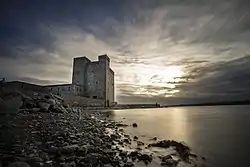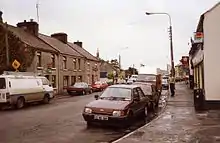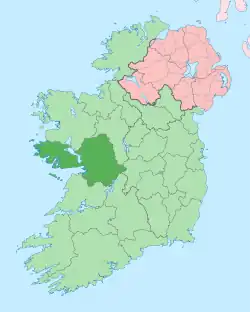Oranmore
Órán Mór | |
|---|---|
Town | |
 Oranmore Castle | |
 Oranmore Location in Ireland | |
| Coordinates: 53°16′06″N 8°55′12″W / 53.2683°N 8.92°W | |
| Country | Ireland |
| Province | Connacht |
| County | County Galway |
| Elevation | 7 m (23 ft) |
| Population | 5,819 |
| Time zone | UTC+0 (WET) |
| • Summer (DST) | UTC-1 (IST (WEST)) |
| Irish Grid Reference | M386245 |
Oranmore (Irish: Órán Mór or Úarán Mór)[2] is a town near the city of Galway in County Galway, Ireland. It is also the name of the civil parish and Roman Catholic parish in which the town lies.
It is 9 km (5.6 mi) east of Galway city on the edge of Oranmore Bay, an inlet of Galway Bay.
Etymology
Oranmore is the anglicisation of Uarán Mór or Órán Mór.[2] The first written record of Oranmore is in the Annals of the Four Masters.[3] It was originally called Fuarán Mór, meaning "great spring" in Irish. This name reputedly refers to a spring or well near the village.[4]
History
Pre-history
Evidence of prehistoric settlement in the Oranmore Parish area include a number of fulacht fiadh (at Frenchfort townland), ringforts (Rinn townland) and a megalithic structure (at Garraun South townland).[5] Griffith's Valuation, a land survey completed in 1857, shows several such structures (sometimes colloquially and collectively known as fairy forts) in the area.
Medieval church ruins
The ruin of a medieval Roman Catholic church is one of the oldest buildings in Oranmore town. Its northern wall forms part of the enclosure which encompasses the church and its graveyard. The church is believed to date to the 13th century. If true, this means it was built no later than one and half century's after the initial Anglo-Norman Invasion of 1169 AD.[6]
The existing remains measure approximately 32 feet by 72 feet, however, there is evidence that the church was larger at one time. Some grave markers in the adjoining cemetery have no discernible name or date. Other graves have been marked with pieces of the fallen church walls. The oldest grave stone, with a discernible date inscription, is a Celtic cross dated 1661. It is no longer in its original location, but is instead lying on top of another, newer stone slab.[6][7]
There is a gated section within the graveyard set aside for the Presentation Sisters, an order of teaching sisters who established a convent in Oranmore in 1861. Some interments occurred within the ruined walls of the actual church.[6]
Oranmore Castle
Oranmore Castle is a tower house which was originally associated with the Norman Clanricarde family. It was built around the 15th century, reputedly on the site of an earlier structure.[8]
St Mary's church
%252C_County_Galway%252C_Ireland_(2012).jpg.webp)
Completed in 1803,[9] St Mary's is a large church building with a bell-cote above the front door and an elaborate ceiling. In 1972, it was replaced as the local parish church with the newer, larger Church of the Immaculate Conception. St Mary's was deconsecrated and converted to become the town's public library. Its carved baptismal font was moved to the new church, but the graveyard was left intact.[10]
Economy
The focus of industry has shifted from dairy agriculture to tourism, manufacturing and logistics.[11] Oranmore has four hotels and 23 restaurants.
Transport
Oranmore town is near the old N6 Galway to Dublin road and the old N18 from Galway to Limerick. The M6 Motorway connects to the existing road at Doughiska, as well as connecting with the M18 at Glenascaul. The former N6 leading into Oranmore has been reclassified as the R338 regional road. The M18 motorway was officially opened on 27 September 2017 and connects to the M6 at Rathmorrissey at a three-level interchange. This road runs close to Oranmore but does not connect directly to it, and instead, motorists have to access it using the R381 at Kiltiernan or the M6 at Rathmorrissey.
Bus Éireann, Citylink, and Nestor Bus services through Oranmore serve Galway, Dublin, Cork, and Dublin and Shannon Airports.
Oranmore Aerodrome was a Royal Air Force base in World War I. It later became a civil airfield serving the city of Galway.
Rail
Oranmore railway station opened on 1 August 1851, closed on 17 June 1963. A new station was built 1.4 km west of the original station and was opened on 28 July 2013.[12][13] Trains connect directly with Galway, Athenry, Athlone, Portarlington, Kildare and Dublin Heuston, as well as on the Western Rail Corridor to Ennis and Limerick.
Education
Oranmore has three primary schools, Scoil Iosaif Naofa, Scoil Mhuire and Gaelscoil de hÍde. Calasanctius College, founded in 1861 by the Presentation Sisters, is the secondary school in Oranmore.
Sport
Oranmore-Maree GAA is the local GAA club, and has won a number county titles across several age groups, including a Galway Senior Hurling Championship title in 1933 and All-Ireland Intermediate Club Hurling Championship title in 2019. The club fields teams in Gaelic football, hurling and camogie. Naomh Mhuire Ladies Football Club (Oranmore Maree) fields ladies' Gaelic football teams from under-10 to minor and junior.
Maree/Oranmore Soccer Club was founded in 1988. Galway Bay Golf Resort is located in Renvile, Oranmore,[14] and has been named best golf resort in Connacht 10 times. Other clubs in the area include the Oranmore Badminton Club, Maree Badminton Club, Maree Basketball Club, Oranmore Judo Club and Galway Bay Sailing Club. The latter is based in Renville, Oranmore.[15] Junior "Park Run" events are run on Sunday mornings.[16]
People

- Joseph Henry Blake, nobleman and socialist, grew up on a nearby estate in Treanlaur, Maree
- Niall Burke, Galway hurler
- Aaron Connolly, professional Premier League footballer
- Nicola Coughlan, Irish actress who had roles in Derry Girls and Bridgerton[17]
- Joe Howley, a member of the Irish Volunteers who was killed in 1920 during the Irish War of Independence, is commemorated by a statue in Oranmore.[18]
- Bill King, round-the-world sailor and owner of Oranmore Castle.[19]
- Célestin Lainé, leader of the Bezen Perrot SS unit, lived in Oranmore after World War II.[20]
- Hildegarde Naughton, politician
- Thomas Nicholas Redington, Irish politician, born here.[21]
See also
References
- ↑ "Profile 1 - Population Distribution and Movement F1015 - Population: Oranmore, Co. Galway". Central Statistics Office (Ireland). Retrieved 21 July 2023.
- 1 2 "Órán Mór / Oranmore (see scanned records)". logainm.ie. Placenames Database of Ireland. Retrieved 10 May 2021.
- ↑ "Ordnance Survey Letters of Galway". places.galwaylibrary.ie.
- ↑ Oranmore Area Biodiversity Plan 2021~2024 (PDF). burrenbeo.com (Report). Oranmore Tidy Towns. p. 8. Retrieved 4 September 2023.
Oranmore gets its name from a spring well located on the Station Road. It was originally called Fuaran Mór (great spring) but in time the "F" was dropped
- ↑ "Recorded Monuments Protected under Section 12 of the National Monuments Act - County Galway" (PDF). archaeology.ie. Office of Public Works. 1997. Retrieved 27 August 2020.
- 1 2 3 Memories in Stone - A Survey of the Old Graveyard - Oranmore. Oranmore Heritage. 2010.
- ↑ "Medieval Graveyard". Galway County Heritage Office. Retrieved 26 August 2020.
- ↑ "Oranmore Castle - History". oranmorecastle.com. Archived from the original on 5 November 2020. Retrieved 27 August 2020.
- ↑ "Oranmore Library, Oranmore, County Galway". buildingsofireland.ie. National Inventory of Architectural Heritage. Retrieved 27 August 2020.
- ↑ "St Mary's Church". Galway County Heritage Office. Retrieved 25 August 2020.
- ↑ Rural Economic Development in Ireland, L Delheure, M Heneghan, R Jackson, D Meredith, 2014
- ↑ "Oranmore station" (PDF). Railscot – Irish Railways. Retrieved 22 November 2007.
- ↑ Transport Minister to open Oranmore rail station Archived 5 July 2013 at archive.today - connacht tribune 23/06/13
- ↑ "Home - Galway Bay Golf Resort".
- ↑ "Galway Bay Sailing Club".
- ↑ "Oranmore junior parkrun". parkrun.ie.
- ↑ "Nicola Coughlan looks unrecognisable in rare throwback pictures of teen years as she shares peek into Galway childhood". galwaybeo.ie. 22 August 2022.
- ↑ "IrishWarMemorials.ie - Howley Memorial - Oranmore". irishwarmemorials.ie.
- ↑ "Connacht Tribune -". connachttribune.ie. Archived from the original on 3 March 2012.
- ↑ "Liberators and victims: Ireland and the Holocaust". independent.ie. 20 January 2020.
Another notorious war criminal welcomed into Ireland was Célestin Lainé, leader of the Bezen Perrot, an SS unit responsible for the torture and murder of civilians in occupied Brittany. Laine was believed to have lived in Coolock in Dublin and after that in Oranmore in Galway
- ↑ . Dictionary of National Biography. London: Smith, Elder & Co. 1885–1900.
